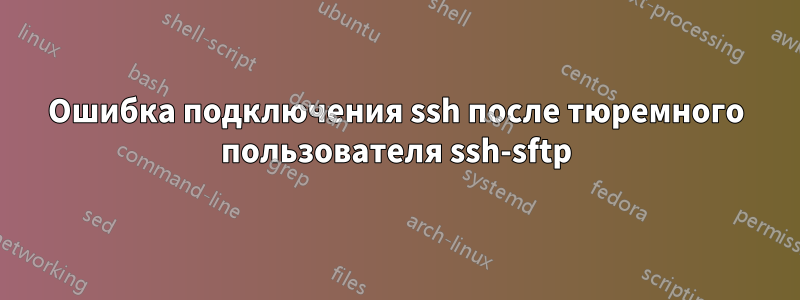
Чего я хочу:
Я хочу создать пользователя для доступа к /var/www/laravel Я создаю демо-пользователя, я следовал этому руководству https://support.rackspace.com/how-to/how-to-add-linux-user-with-document-root-permissions/
Я могу подключиться и увидеть каталог, папку, редактировать, открывать, загружать и т. д., но я не хочу, чтобы этот пользователь выходил из этого каталога или переходил в домашний или другой каталог...
когда я следую уроку о том, как посадить пользователя в тюрьму
Я следовал этому уроку https://askubuntu.com/a/144093
в конце файла
/etc/ssh/sshd_config
Мне нужно это положить...
Subsystem sftp internal-sftp
Match User demo
ChrootDirectory %h
ForceCommand internal-sftp
AllowTcpForwarding no
и прокомментируйте эту строку
#Subsystem sftp /usr/lib/openssh/sftp-server
PD: и перезапустите sshservice ssh restart
но когда я это делаю, я не могу подключиться через ssh-sftp, я использую Bitvise и он показывает мне ошибку:
windows error 10054
http://kb.globalscape.com/KnowledgebaseArticle10235.aspx
Мой файл /etc/ssh/sshd_config
# Package generated configuration file
# See the sshd_config(5) manpage for details
# What ports, IPs and protocols we listen for
Port 22
# Use these options to restrict which interfaces/protocols sshd will bind to
#ListenAddress ::
#ListenAddress 0.0.0.0
Protocol 2
# HostKeys for protocol version 2
HostKey /etc/ssh/ssh_host_rsa_key
HostKey /etc/ssh/ssh_host_dsa_key
HostKey /etc/ssh/ssh_host_ecdsa_key
HostKey /etc/ssh/ssh_host_ed25519_key
#Privilege Separation is turned on for security
UsePrivilegeSeparation yes
# Lifetime and size of ephemeral version 1 server key
KeyRegenerationInterval 3600
ServerKeyBits 1024
# Logging
SyslogFacility AUTH
LogLevel INFO
# Authentication:
LoginGraceTime 120
PermitRootLogin without-password
StrictModes yes
RSAAuthentication yes
PubkeyAuthentication yes
#AuthorizedKeysFile %h/.ssh/authorized_keys
# Don't read the user's ~/.rhosts and ~/.shosts files
IgnoreRhosts yes
# For this to work you will also need host keys in /etc/ssh_known_hosts
RhostsRSAAuthentication no
# similar for protocol version 2
HostbasedAuthentication no
# Uncomment if you don't trust ~/.ssh/known_hosts for RhostsRSAAuthentication
#IgnoreUserKnownHosts yes
# To enable empty passwords, change to yes (NOT RECOMMENDED)
PermitEmptyPasswords no
# Change to yes to enable challenge-response passwords (beware issues with
# some PAM modules and threads)
ChallengeResponseAuthentication no
# Change to no to disable tunnelled clear text passwords
#PasswordAuthentication yes
# Kerberos options
#KerberosAuthentication no
#KerberosGetAFSToken no
#KerberosOrLocalPasswd yes
#KerberosTicketCleanup yes
# GSSAPI options
#GSSAPIAuthentication no
#GSSAPICleanupCredentials yes
X11Forwarding yes
X11DisplayOffset 10
PrintMotd no
PrintLastLog yes
TCPKeepAlive yes
#UseLogin no
#MaxStartups 10:30:60
#Banner /etc/issue.net
# Allow client to pass locale environment variables
AcceptEnv LANG LC_*
#Subsystem sftp /usr/lib/openssh/sftp-server
# Set this to 'yes' to enable PAM authentication, account processing,
# and session processing. If this is enabled, PAM authentication will
# be allowed through the ChallengeResponseAuthentication and
# PasswordAuthentication. Depending on your PAM configuration,
# PAM authentication via ChallengeResponseAuthentication may bypass
# the setting of "PermitRootLogin without-password".
# If you just want the PAM account and session checks to run without
# PAM authentication, then enable this but set PasswordAuthentication
# and ChallengeResponseAuthentication to 'no'.
UsePAM yes
Subsystem sftp internal-sftp
Match User demo
ChrootDirectory %h
ForceCommand internal-sftp
AllowTcpForwarding no
решение1
Есть страница руководства sshd_config(5), и она содержит всю информацию для всего, что вы хотите настроить свой сервер. Для вас есть важная часть о chroot-каталоге:
ChrootDirectory
Указывает путь к каталогу, в который будет выполнен chroot(2) после аутентификации. При запуске сеанса sshd(8) проверяет, что все компоненты пути являются каталогами, принадлежащими пользователю root, которые не доступны для записи другим пользователям или группам. После chroot sshd(8) изменяет рабочий каталог на домашний каталог пользователя.
Это означает, что вам необходимо выполнить:
chown root:root /var/www
chmod go-w /var/www
Это ответ


